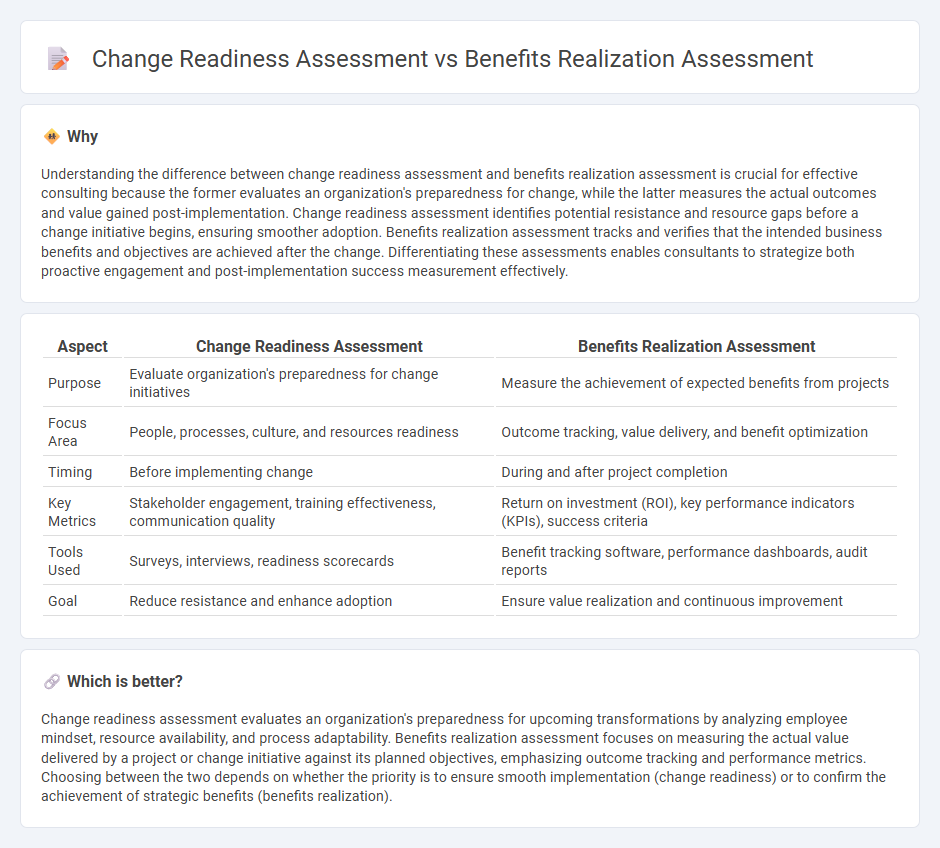
Change readiness assessment evaluates an organization's preparedness by analyzing employee engagement, leadership alignment, and resource availability to ensure successful project adoption. Benefits realization assessment measures the actual outcomes and value achieved against initial project objectives, focusing on performance metrics and ROI. Discover how these assessments can strategically guide your business transformation efforts.
Why it is important
Understanding the difference between change readiness assessment and benefits realization assessment is crucial for effective consulting because the former evaluates an organization's preparedness for change, while the latter measures the actual outcomes and value gained post-implementation. Change readiness assessment identifies potential resistance and resource gaps before a change initiative begins, ensuring smoother adoption. Benefits realization assessment tracks and verifies that the intended business benefits and objectives are achieved after the change. Differentiating these assessments enables consultants to strategize both proactive engagement and post-implementation success measurement effectively.
Comparison Table
| Aspect | Change Readiness Assessment | Benefits Realization Assessment |
|---|---|---|
| Purpose | Evaluate organization's preparedness for change initiatives | Measure the achievement of expected benefits from projects |
| Focus Area | People, processes, culture, and resources readiness | Outcome tracking, value delivery, and benefit optimization |
| Timing | Before implementing change | During and after project completion |
| Key Metrics | Stakeholder engagement, training effectiveness, communication quality | Return on investment (ROI), key performance indicators (KPIs), success criteria |
| Tools Used | Surveys, interviews, readiness scorecards | Benefit tracking software, performance dashboards, audit reports |
| Goal | Reduce resistance and enhance adoption | Ensure value realization and continuous improvement |
Which is better?
Change readiness assessment evaluates an organization's preparedness for upcoming transformations by analyzing employee mindset, resource availability, and process adaptability. Benefits realization assessment focuses on measuring the actual value delivered by a project or change initiative against its planned objectives, emphasizing outcome tracking and performance metrics. Choosing between the two depends on whether the priority is to ensure smooth implementation (change readiness) or to confirm the achievement of strategic benefits (benefits realization).
Connection
Change readiness assessment evaluates an organization's preparedness for upcoming transformations by analyzing employee engagement, leadership support, and existing processes. Benefits realization assessment measures the extent to which these planned changes achieve their intended outcomes and deliver business value. Together, these assessments ensure that readiness factors align with actual benefits, enabling continuous improvement and successful change management execution.
Key Terms
**Benefits Realization Assessment:**
Benefits Realization Assessment evaluates the effectiveness of project outcomes in delivering anticipated value, measuring whether strategic objectives and key performance indicators (KPIs) are met post-implementation. This assessment quantifies tangible and intangible benefits, ensuring alignment with business goals and identifying gaps between expected and actual results. Explore how Benefits Realization Assessment drives continuous improvement and maximizes return on investment for your organization.
Value Delivery
Benefits realization assessment measures the extent to which a project or change initiative delivers its intended value by tracking key performance indicators and outcomes against predefined objectives. Change readiness assessment evaluates an organization's preparedness to implement change effectively, focusing on employee engagement, resource availability, and potential resistance. Explore deeper insights into optimizing value delivery through integrated assessments.
Performance Metrics
Benefits realization assessment centers on measuring the achievement of predefined performance metrics such as return on investment (ROI), cost savings, and productivity improvements to evaluate project success. Change readiness assessment evaluates an organization's preparedness by examining employee engagement levels, communication effectiveness, and training completion rates that impact the adoption of new processes. Discover more about how these assessments drive strategic project outcomes and organizational transformation.
Source and External Links
Benefits Realization Plan test - A Benefits Realization Plan in program management outlines how expected benefits will be identified, assigned ownership, measured, timed, and sustained to ensure value delivery to an organization and its stakeholders.
Mastering Benefits Realization (Outcome Management) - Benefits realization management ensures organizations achieve optimal value from investments by estimating, forecasting, measuring, and managing benefit delivery through defined metrics and addressing variances.
Benefits Realization and Portfolio Value Management - Benefits realization captures actual benefits post-project completion, supporting improved business case development, accurate forecasting validation, lessons learned, and stronger portfolio value management through defined processes and benefit ownership.
 dowidth.com
dowidth.com